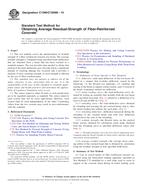Potřebujeme váš souhlas k využití jednotlivých dat, aby se vám mimo jiné mohly ukazovat informace týkající se vašich zájmů. Souhlas udělíte kliknutím na tlačítko „OK“.
ASTM C1399/C1399M-10
Standard Test Method for Obtaining Average Residual-Strength of Fiber-Reinforced Concrete
Automaticky přeložený název:
Standardní zkušební metoda pro získání průměrné zbytkové pevnosti vlákny vyztuženého betonu
NORMA vydána dne 1.1.2010
Informace o normě:
Označení normy: ASTM C1399/C1399M-10
Poznámka: NEPLATNÁ
Datum vydání normy: 1.1.2010
Kód zboží: NS-11042
Počet stran: 6
Přibližná hmotnost: 18 g (0.04 liber)
Země: Americká technická norma
Kategorie: Technické normy ASTM
Anotace textu normy ASTM C1399/C1399M-10 :
Keywords:
fiber-reinforced concrete, residual strength, flexure testing, post cracking strength, Beam deflection, Fiber-reinforced concrete, Flexural testing--concrete, Post cracking strength, Residual strength, ICS Number Code 91.100.30 (Concrete and concrete products)
Doplňující informace
| Significance and Use | ||||||||||||||
|
This test method provides a quantitative measure useful in the evaluation of the performance of fiber–reinforced concrete. It allows for comparative analysis among beams containing different fiber types, including materials, dimension and shape, and different fiber contents. Results can be used to optimize the proportions of fiber–reinforced concrete mixtures, to determine compliance with construction specifications, to evaluate fiber–reinforced concrete which has been in service, and as a tool for research and development of fiber–reinforced concrete (See Note 2). Note 2—Banthia and Dubey compared results using this test method with residual strengths at the same net deflections using a test protocol that is similar to that described in Test Method C1609/C1609M on 45 beams with a single fiber configuration at proportions of 0.1, 0.3, and 0.5 % by volume. The results by this test method were on average 6.4 % lower than by the procedure of Test Method C1609/C1609M. Test results are intended to reflect either consistency or differences among variables used in proportioning the fiber–reinforced concrete to be tested, including fiber type (material), fiber size and shape, fiber amount, beam preparation (sawed or molded), and beam conditioning. In molded beams fiber orientation near molded surfaces will be affected by the process of molding. For tests of fiber-reinforced concrete containing relatively rigid or stiff fibers of length greater than 35 mm [1.4 in.], the use of sawed beams cut from samples with an initial width and depth of at least 3 times the length of the fiber is required to minimize effects of fiber orientation. When sawed beams are employed, and to avoid the effects of fiber orientation, care shall be applied to ensure that the flexural tensile surface of the beam is a sawed surface. |
||||||||||||||
| 1. Scope | ||||||||||||||
|
1.1 This test method covers the determination of residual strength of a fiber–reinforced concrete test beam. The average residual strength is computed using specified beam deflections that are obtained from a beam that has been cracked in a standard manner. The test provides data needed to obtain that portion of the load–deflection curve beyond which a significant amount of cracking damage has occurred and it provides a measure of post–cracking strength, as such strength is affected by the use of fiber–reinforcement. 1.2 This standard does not purport to address all of the safety concerns, if any, associated with its use. It is the responsibility of the user of this standard to establish appropriate safety and health practices and determine the applicability of regulatory limitations prior to use. 1.3 The values stated in either SI units or inch-pound units are to be regarded separately as standard. The values stated in each system may not be exact equivalents; therefore, each system shall be used independently of the other. Combining values from the two systems may result in non-conformance with the standard. |
||||||||||||||
| 2. Referenced Documents | ||||||||||||||
|
Doporučujeme:
EviZak - všechny zákony včetně jejich evidence na jednom místě
Poskytování aktuálních informací o legislativních předpisech vyhlášených ve Sbírce zákonů od roku 1945.
Aktualizace 2x v měsíci !
Chcete vědět více informací? Podívejte se na tuto stránku.




 Cookies
Cookies
